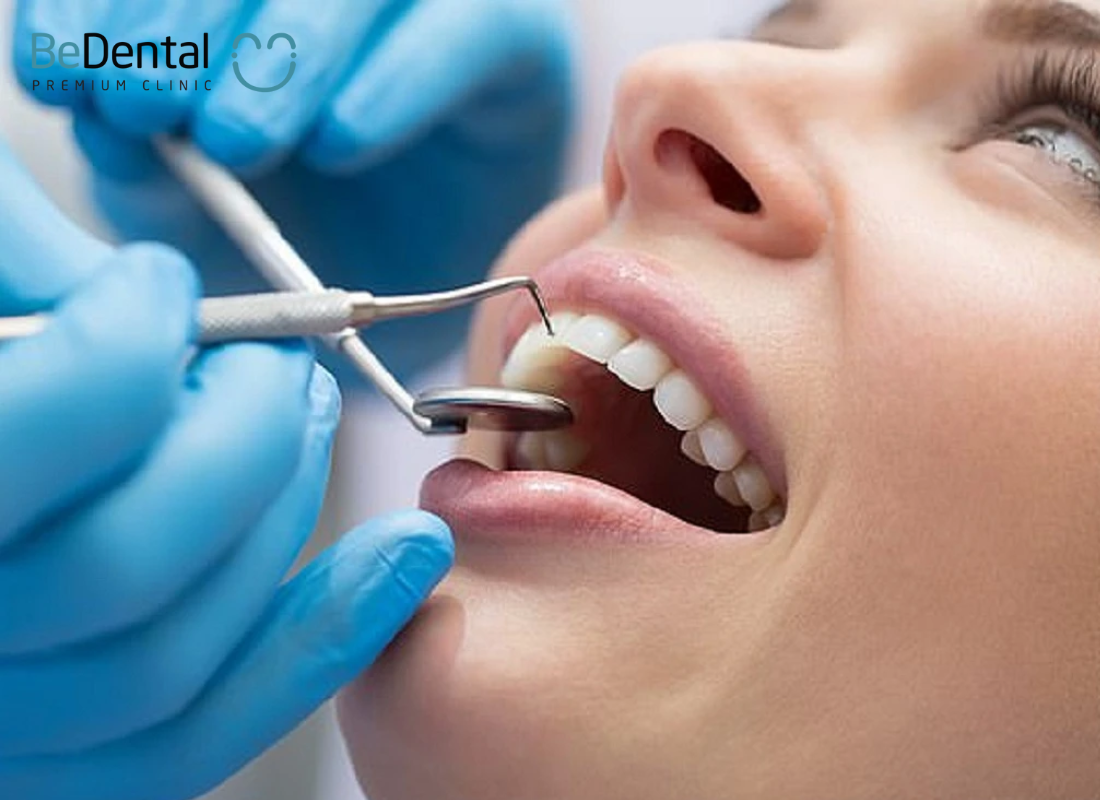MTA Dental Fillings and 9 superior properties of MTA in dental fillings. In recent years, dental filling techniques have always been popular in cases of treating damaged teeth or cosmetic restorations. In order to fully meet customer needs in terms of durability, aesthetics and cost, a series of dental filling materials have appeared. Prominent among them, MTA is currently the dental filling material sought after by many people. So what is MTA dental filling?
In what cases is MTA material indicated for use? Where is a reputable and cheap place to perform MTA dental fillings? All questions about dental MTA materials will be answered by BeDental in the following article.
What is MTA dental filling?
What is MTA dental filling? MTA dental filling is one of the dental filling materials used quite a lot in dental treatment today. Even in difficult cases such as filling root canals, MTA is the perfect choice. It is known that MTA is a synthetic cement developed by Dr. Mahmoud Torabinejad of Loma Linda University, California.
MTA is the acronym for Mineral Trioxide Aggregate. This material is widely used in dentistry because of a series of outstanding advantages. Furthermore, MTA was also tested and approved for safety by the American Dental Association in 1993. Therefore, MTA material is widely used in internal medicine repair, root closure and tooth conservation.
The composition table of MTA includes Trioxide basic particles such as tricalcium oxide, silicate oxide, bismuth oxide, tricalcium silicate, tricalcium aluminate. Usually when MTA is mixed with liquid it will quickly turn into a gel and gradually harden after about 3-4 hours.
MTA dental filling technique is simple and highly effective. Similar to other materials, the dentist will examine and use MTA material to fill holes and damage on teeth. Thereby helping to preserve old teeth, creating a new protective layer from bacterial attacks and external influences.
9 superior properties of MTA in dental fillings
It is no coincidence that MTA dental filling material is loved by so many users. Compared to other dental filling materials on the market, MTA dental fillings offer many outstanding advantages. Below are 9 superior features of MTA in dental filling techniques as well as other endodontic treatments:
Provides tightness
When performing dental fillings, MTA will create protective layers and fill holes more perfectly than other dental filling materials. Even compared to Amalgam, Super EBA or IRM silver filling materials, MTA still achieves lower leakage levels. In particular, even when encountering moisture contamination, MTA dental fillings provide almost absolute tightness.

In particular, MTA is a substance that is not affected by the presence of blood. Because the tightness of MTA material comes from its hydrophilic nature and slight expansion in humid environmental conditions. Therefore, you can completely feel secure when performing dental fillings with MTA material without fear of expansion or shrinkage by environmental conditions.
Solubility of MTA
The environment in the oral cavity is always moist. Therefore, most dental filling materials will be affected and eroded by moisture, which is called solubility.
However, MTA is a material that does not show signs of being dissolved by water. Therefore, the durability of MTA dental fillings is often highly appreciated. Like Amalgam or Super EBA, MTA is not soluble in water.
Small note: Although not soluble in water, MTA will also dissolve in acidic pH. Therefore, when performing dental fillings with MTA material, you should also build a scientific diet to avoid having to re-fill too many times.
Compressive strength
MTA is one of the dental filling materials that is highly appreciated because of its good compressive strength. Compared to IRM materials, the compressive strength is also increased in the presence of limited moisture. Specifically, over time, the compressive strength will change, from 40 MPA in 24 hours to 70 MPA after 21 days.
Besides, the hardness, also known as compressive strength, of MTA is also comparable to IRM and Super EBA. However, this durability is a bit lower than Amalgam silver fillings. But overall, MTA’s compressive strength is still highly appreciated because it is quite balanced.
See more: Cavities on the Outer and Inner Surfaces and Some Appropriate Treatment Directions
Dental MTA material is resistant to displacement or dispersion
MTA material in dentistry has the ability to connect to the tube wall after performing MTA tooth filling. The reason they are able to do so is due to their ability to establish resistance to complete separation from the partitions when movement occurs, usually within the first 24 hours.
Besides, MTA also has good compatibility with the dentin walls at the tip of the tooth. Compared to other dental filling materials such as Amalgam, Super EBA or IRM, MTA material is rated much higher.
Setting and hardening time
When performing dental fillings, the setting time of the materials is an extremely important factor. Firstly, they will help shorten the recovery time and abstain from fillings. 2 is to bring beautiful durability while still helping to save time. 3: Fast curing time will help the filling process go faster, reducing pain and lasting discomfort.

Meanwhile, MTA material has an average hardening time of about 3 hours. This time may vary depending on the size of the particles and the ratio of powder and water. Besides, temperature, air,… also have more or less impact.
With MTA, the setting time also helps reduce shrinkage. A period of time that is not too fast, not too slow will help create a perfect filling shape and limit bacterial leakage. Thanks to that, it provides stable performance in size after long periods of use.
Optical resistance of MTA material in dentistry
Compared to IRM and Super EBA materials, the optical resistance of MTA is much higher. Therefore, the effect of dental fillings is also much more beautiful and durable.
Biocompatibility
MTA material possesses a superior property that some other materials do not have: antibacterial properties. Therefore, MTA is not only applied in dental fillings but also participates in many other dental treatment cases.
The antibacterial effect of MTA material is highly appreciated. For some common bacteria, MTA has been clinically tested for its effectiveness when filling with this material. Thanks to its good antibacterial ability, MTA is widely used in root canal treatment: covering the pulp, perforating the pulp floor, repairing periapical lesions…
Cellular reactivity and mutagenicity are very low
Compared to other materials such as IRM, Super EBA and Amalgam, MTA material is less toxic or causes other reactions to occur in the body. Besides, the GEN mutagenicity of MTA is absent.
Therefore, you can feel completely secure when performing dental fillings without fear that in the future, dental fillings will negatively affect your overall health. For example, the mercury component in Amalgam is harmful, so currently very few dental facilities use it to perform fillings.
Tissue response
In fact, researchers have shown: MTA contributes significantly to the process of promoting the formation of hard tissue. For example, direct bone formation. Besides, MTA also has an induction effect on cementoblasts.
Putting it on the scale, MTA is not only a filling material to fix tooth defects but also has the ability to restore. The entire MTA dental filling process is highly effective without any inflammatory reaction. So enough to see, MTA is quite safe for human health in the long term.
Cases where MTA teeth should and should not be filled
Not all cases of filling gaps or chipped teeth require MTA to fill and seal the damage. Usually you will be prescribed MTA welding when you experience serious dental damage. Specifically, MTA dental filling is indicated in one of the following cases:
- The tooth has a hole in the floor and is too late.
- Perform apical filling or patching of root canal walls.
- The apex is not completely closed.
- Treatment of infections around tooth roots.
- Tooth root closure treatment is needed.
- Dental root resorption treatment.
Besides, there are also cases where the use of MTA in dental fillings is contraindicated:
- Teeth have severe inflammation.
- The tooth has pulpitis but is exposed.
- Teeth with locally or completely calcified pulp tissue should not use MTA.
- Clients with acute or progressive systemic infections should temporarily refrain from dental fillings with MTA.
See more: Deviation of the philtrum and some effective methods to treat deviation of the philtrum
Is MTA tooth filling painful?
MTA tooth filling technique is currently quite commonly performed. In particular, in cases of dental fillings with severe damage, MTA is the perfect material. So is MTA tooth filling painful?
In fact, the level of pain or discomfort when filling teeth depends a lot on the machine, technology and your skills. You will be committed to painless tooth filling when and only when performed at quality, reputable dental facilities. On the contrary, if it is performed by a poorly skilled doctor who is clumsy in handling root canal treatment or tooth filling, it is likely that you will feel uncomfortable during the entire procedure.

Is the cost of MTA tooth filling expensive?
Usually MTA dental fillings are indicated in cases where root canal treatment is required. Because with sparse, chipped or slightly decayed teeth, choosing other materials will be more optimal. So currently, are MTA dental fillings expensive?
Whether dental fillings are expensive or not depends on many factors. Most of the time, filling with MTA material is only done in cases of pulp damage or in root closure techniques. Therefore, the cost of MTA tooth filling will depend on the condition of tooth damage encountered.
To receive an accurate price, you should visit a reputable dental clinic directly. Most of these places offer free examinations and quotes before proceeding. You should stay away from establishments that are less reputable and do not quote clear prices to avoid “losing money”.
See more: Is Eugenate Dental Filling Good? Is Eugenate Temporary Sealant Durable?
BeDental – MTA dental filling address with reputation, quality, and reasonable prices
Most cases where MTA dental fillings are indicated are difficult cases. Therefore, you should not subjectively look for less reputable addresses to do it. Because in reality, tooth filling combined with root canal treatment with MTA is a quite complicated technique that requires a high level of skill from the doctor performing it. So where is the reputable address so you can feel 100% secure?
You can refer to the MTA dental filling service at BeDental because:
- We have a team of good dentists with many years of experience in handling difficult dental treatment cases. In every situation, doctors can flexibly control and handle it so that no complications occur.
- All materials used by BeDental MTA are tested for safety and are guaranteed to be 100% genuine. Therefore, it brings aesthetic results, dental treatment and absolute safety.
- The price for MTA tooth filling will be specifically informed before proceeding. The doctor will usually quote a price after a general examination of the dental situation. Thanks to that, the quoted price always follows the actual treatment and you can also prepare the best.
What to note after performing MTA tooth filling?
Similar to performing dental fillings with other materials, after MTA dental fillings, you also need to have a careful diet and hygiene to avoid removing the fillings. Specifically:
- You should eat soft foods such as porridge, soup, etc.
- Add lots of green vegetables and fresh fruits containing fiber, vitamins and minerals.
- Prioritize drinking milk containing calcium to speed up the healing of dental wounds.
- When cleaning your teeth, brush your teeth gently and avoid applying force to the area that has just been filled.
- Get into the habit of using physiological saline to rinse your mouth and dental floss to remove leftover food stuck between teeth after each meal.
- Follow a regular check-up schedule to monitor dental fillings.

The above article has helped you learn thoroughly about the MTA dental filling technique. It can be seen that MTA is a dental filling material to repair teeth that are severely damaged or require complex endodontic treatment. Contact BeDental directly for free consultation on MTA dental filling techniques.
Reference price list:
Danh mục Unit Giá thành
1.Teeth filling (More detail...)
Baby teeth filling 1 Unit 250.000
~ 10$
Permanent Teeth Filling 1 Unit 500.000
~ 20$
Cosmetic Filling1 Unit 700.000
~ 28$
Sensitive teeth filling1 Unit 500.000
~ 20$
Composite bonding 1 Unit 1.000.000
~ 40$
2.Root Canal Treatment - Anterior by endodontist machine (More detail...)
Root Canal Treatment - Anterior for baby teeth 1 Unit 800.000
~ 31$
Root Canal Treatment - Anterior for Front teeth 1 Unit 1.200.000
~ 47$
Root Canal Treatment - Anterior for Premolar teeth 1 Unit 1.500.000
~ 59$
Root Canal Treatment - Anterior for molar teeth 1 Unit 2.000.000
~ 79$
3.Root Canal reTreatment - Anterior by endodontist machine
Root Canal Treatment - Anterior for Front teeth by endodontist machine 1 Unit 1.500.000
~ 59$
Anterior for Premolar teeth by endodontist machine 1 Unit 1.800.000
~ 71$
Anterior for molar teeth by endodontist machine 1 Unit 2.300.000
~ 90$
4 Vecniflour dental care (More detail...)
Vecniflour dental care for child 1 Unit 500.000
~ 20$
See more: Dentures are smelly and painful- Causes and some solutions
BEDENTAL - TOP STANDARD DENTISTRY SYSTEM
In HANOI
Address 1: 7B Thi Sach St, Ngo Thi Nham, Hai Ba Trung Dist, Ha Noi. - 0934.61.9090
Address 2: No 129 Hoang Ngan, Yen Hoa, Cau Giay Dist, Ha Noi. - 0934.61.9090
In HO CHI MINH
Address 1: 53 -55 -57 Pho Duc Chinh St, Nguyen Thai Binh, Dist. 1, Ho Chi Minh. - 0766.00.8080
Working: 9am - 8pm everyday
Website: https://bedental.vn/en/




